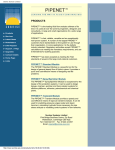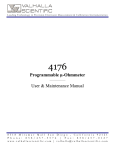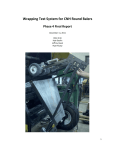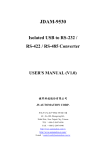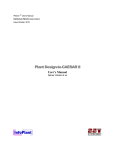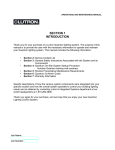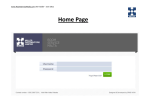Download PIPENET News March 10
Transcript
-1- VOLUME 2 – ISSUE 6 Winter 2009 / 2010 NEWS! Welcome to the PIPENET Vision 1.40 is now available! PIPENET e-newsletter! PIPENET Vision 1.40 is now being sent to all subscribers to PIPENET Maintenance, Updates and Support. Contents: 1. PIPENET Vision 1.40 New Features Page 2 2. Inertial Pump and the Applications A new feature in PIPENET Vision 1.40 If you would like to receive a copy, email us with your company name and contact details at: [email protected] PIPENET Vision 1.22 is the very latest version of We look toby hearing from you! PIPENET fullyforward supported our Technical Support Team. NEWS! Page 3 3. Converting the PIPENET Result report to Excel Page 7 4. PIPENET Transient Module and Composite Material Pipes Page 11 PIPENET Vision 1.40 out now PIPENET 1.40 is now available! It contains powerful new capabilities in all of the PIPENET modules. Please see page 2 for full details of the exciting new range of feature additions and enhancements now 5. Importing and exporting into PIPENET Vision available to PIPENET users. Page 11 Also included in this edition is news of our work towards 6. Specifying Standard Bends in Pipe Work Page 12 new demonstrations and releases, and of course, an edition of PIPENET News would not be complete without some examples of how to make the best of PIPENET . 7. Marketing Partners, Training Manuals and PIPENET News! Page 12 & 13 Page 1 We hope you will enjoy it! PIPENET Leading The Way in Fluid Flow Analysis PIPENET Vision 1.40 includes… Transient Module · A new inertial pump component has been added · Maximum & minimum pressures are displayed for each component in both the Properties and Data Windows, upon completion of a calculation · Velocity can now appear as a variable type when defining output tables for pipes · Forces extrema and pipe type extrema can be displayed in the data window (Tabular Results page) · KPa & MPa pressure units have been added · The appearance of the forces diaglog is even more user friendly · The two node caisson is enhanced · The maximum pipe size in the Spray mode of the Transient module is increased. It is now 1200mm / 48inches, with 6 new nominal pipe sizes · The improved accumulator model can simulate the effect of different gases in addition to air Spray/Sprinkler Module · The hydraulic graph is now NFPA styled in the GUI Data Window & NFPA output repo rt · The maximum number of pipes is increased to 7000 · The maximum number of nozzles is increased to 3000 · KPa & MPa pressure units have been added · Velocity pressure, calculated to NFPA guidelines appears in the NFPA output files Standard Module · A new heat exchanger component has been added · KPa & MPa pressure units have been added · The combined maximum numbe r of pipes and ducts is increased to 7000 · The control valve is improved -2- Graphical Interface · New Explode Node facility – right click on a node containing 2 or more attached components & the node will split into a number of different nodes each attached to just 1 link · Change the colour by left hand clicking on a colour · The Help Menu can now take you straight to the Sunrise Systems website · The Restore Defaults is improved. PIPENET Vision 1.40 includes a new inertial pump component Inertial Pump and the Applications Pump’s start-up and stoppage are two important transient sources in pipeline network. Turbo pump model can predict transient behaviour during pump trip for all four quadrants but Suter curves are not available for most pumps. On the contrary, simple pump model requires pump’s performance curve (H-Q curve) only but the start-up/trip time has to be estimated arbitrarily so that it may be inaccurate and unreliable. The newly developed inertial pump model is designed to predict pump’s steady/transient behaviour in the working region. The required parameters are fewer and feasible comparing with turbo pump. It works like a simple pump at steady state but can simulate transient behaviour during start-up or stoppage. The transient flow during pump switch is studied in the example below. In this scenario, the valve 1 is closed manually in 20 seconds. The main pump 1 will be shut off automatically when the outlet pressure exceeds 8 bars to protect the pump and pipes. The pressure in the main supply pipe 2 will drop continually after the main pump trips until below 4 barg when the stand-by pump 2 is triggered to start up automatically. -3- Pump library Inertial pump is defined in the pump library just like other pumps. The input parameters and curves are quite feasible from manufacturers. The basic input parameters and pump curves include reference fluid density, rated speed, moment of inertia, and Flowrate – Head and Flowrate – Power or Efficiency curves. The above information is enough for pump trip simulation. If pump start-up is simulated, extra data is required, including motor synchronous speed and motor Speed – Torque curve. If the manufacturer cannot provide the moment of inertia, it can be estimated based on the pump size, the rated speed and the rated power. The details refer to the user manual. -4- Pump trip The figure below show the input control signal and the pump speed of the main pump 1 during pump trip. The pump speed decreases quite fast at the beginning when the control signal switch and tends to flat as the time going. Pump start-up In this figure we can conclude that the pump start-up speed is much quick than the pump trip. Display of Maximum and Minimum Maximum & minimum pressures are displayed for each component in both the Properties and Data Window. Force and pipe type maximum and minimum can be displayed in Data Window also. -5- PIPENET Leading The Way in Fluid Flow Analysis -6- Converting the Result Report to Excel There are two methods for converting the Result Report. Method 1: 1. Select the Data Window showing results: Click in this cell 2. Edit/Copy 3. Paste in Excel: 4. It is done : -7- Method 2: 1. Click “Browse output” button after the calculation. “Browse output” button 2. Select “Word” in the “Output options” dialog, then click “OK”. 3. Go to the page which you are interested, select the results which you need and copy them. -8- 4. Go to Excel and do “Paste”. 5. Click Menu->Data->Text to columns. -9- 6. Select “Delimited” and click “Next”. 7. Select “Space” and click “Finish”. 8. Add the headers. - 10 - PIPENET Transient Module and Composite Material Pipes Composite material pipes are increasingly common in low pressure piping systems, such as cooling water systems. This is usually because of lack of corrosion, cost and so on. Interestingly, in some cases logistics has also played a part. There is an application for which PIPENET Transient and Standard modules are being used. The main headers in this application are 3.5 and 4.5 meters in diameter and they are made of GRP. They are more like tunnels than pipes! As these pipes were made of GRP, the vendor simply built a plant on site. (GRP pipe manufacturing is a relatively simple process, in comparison to carbon steel pipe.) One of the disadvantages of using commonly available composite pipes is the fact that they cannot usually withstand a high pressure. This means that phenomena such as water hammer and pressure surge are of concern. This is why PIPENET Transient module is widely used for modelling composite piping systems. Users of PIPENET Transient module can avoid high pressures occurring. However, there is another potential problem which is not always recognised. Typically fittings such as flanges are attached to composite material pipes by the use of adhesives. If such a system is subjected to wild fluctuations in the pressure inside the pipe, there is a tendency for relative movement between the pipe and the flange as the pipe is less rigid than the flange. It is thought that this might lead to the adhesive material cracking and the flange becoming detached from the pipe as a consequence. PIPENET Transient can be used to reduce the amplitude of the pressure oscillations to an acceptable level. The basic message is ‘How to design composite material piping systems in such a way that we can harness all the advantages which such materials offer, and avoid potential disadvantages.’ Supporting composite material piping systems also requires greater care. PIPENET Transient module can calculate the force-time history for the hydraulic forces which can occur in such systems. PIPENET Transient module has an interface with pipe stress analysis programs such as Caesar and Triflex. How can AUTOCAD be imported and exported into PIPENET Vision? We have been asked many times, so, just in case you missed in a previous edition, here it is again 1. Import the AutoCAD drawing (such as a plot, 3. Optimise the PIPENET design and perform the plan or general arrangement drawing) into necessary calculations. PIPENET as a .wmf or .dxf file. 4. This new schematic and other data are exported to AutoCAD by choosing from the PIPENET tool 2. Draw the PIPENET schematic on top of the bar, ‘tools’, ‘export to .dxf’ and finalising the imported drawing. exported schematic as a piping drawing. - 11 - Specifying Standard Bends in Pipe work 1. Click on the relevant pipe to make it active. 2. Click on the fittings tab Selected pipe Click on Add Click Fittings Tab 3. Select the required fitting and click on the Add button. PIPENET Training Manual The PIPENET Development Team have put a lot of work into enhancing the Training Manuals. They are filled with more examples than ever before, for the many applications of PIPENET and really useful if you are a new user or haven’t used PIPENET for a while. We dispatch a training manual (on cd) with every order. If you can’t find your training manual, please do let us know and we will give you another, free of charge. PIPENET Demonstration Do you want to know more about PIPENET? Are you looking for a demonstration? Visit the registration page of www.sunrise-sys.com and ask to see the new PIPENET Vision demonstration of all three modules. - 12 - PIPENET Demonstration We will be releasing new demonstrations very soon, starting with PIPENET Transient Module. Minidemonstrations of around a minute and a half will also be available for each module before the summer. Full details will be in the next edition of PIPENET News, but do watch the ‘latest news’ page of www.sunrisesys.com for news of demonstrations, new service packs and other new developments PIPENET Marketing Partners offer an excellent service to PIPENET users We are pleased to welcome new marketing partners to join the outstanding team of expert PIPENET Marketing Partners across the globe. Many of these PIPENET Marketing Partners now offer · Sales advice · Training in the locality · Technical Support Please do email us: pipenet@sunri se-sys.com if you would like a marketing partner close to you to contact you with further information. PIPENET NEWS If you would like to be added to the PIPENET NEWS circulation list, please email: [email protected]. (If you would prefer to be removed from the circulation list, please email ‘No’ to the same address. Thank you.) PIPENET Maintenance Updates and Support Subscription For a small annual subscription you can ensure that you are always working with the latest version of PIPENET, as well as being assured of assistance from our support. Email [email protected] for more information. PIPENET Vision 1.40 will be sent, free of charge to all customers with a valid Maintenance, Updates and Support contract. PIPENET Customer Feedback. We value customer feedback and comments highly, so we will be very pleased to hear from you. Please give us your comments via the ‘Contact Us’ page of our website www.sunrise-sys.com. - 13 -














